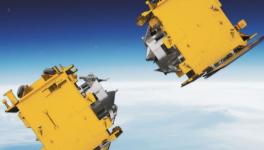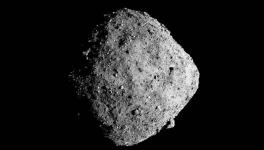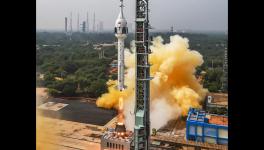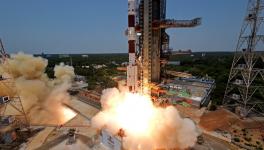Chandrayaan-2 Slips Between Cup and Lip
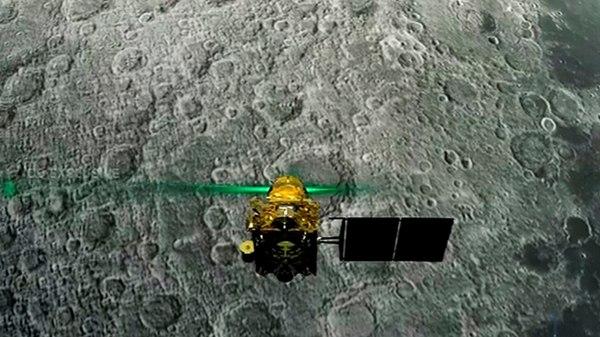
Image Courtesy: Live Mint
After a long, text-book Chandrayaan-2 mission – since its launch on June 22, 2019, till a mere 2 km or so above the lunar surface – the much awaited soft landing of the Vikram Lander in the south polar region of the Moon on September 7, 2019, could not be achieved due to reasons that are yet to be determined. From what little is known at present, it appears that control of the Lander was lost at the very last stage of its descent, and it made a hard landing or, to put it in plain language, crashed, although how badly is still not known. Communication between the Lander and the Indian Space Research Organisation (ISRO) control centre in Bengaluru was also lost before the landing and, even though the link between the Lander and the Orbiter was restored, no communication has been received from the former.
The Chandrayaan-2 Orbiter, which is continuing its flawless orbit around the Moon, has captured infra-red or thermal images of the “crashed” Lander, but no optical images are available in the public domain so far. This suggests that a relatively large segment of the Lander has survived the hard landing, rather than small fragments being scattered on the lunar surface, indicating that the Lander impacted the Moon from a relatively small altitude and at not very high speed. As per reports, ISRO has optimal images now, showing an almost intact Lander near the landing site, but with a pronounced tilt which might indicate broken legs. However, prospects of “reviving” the Lander once communication links are restored appear remote, since the hard landing may have resulted in considerable damage.
Also read: Chandrayaan-2 and the Indian Space Journey
So ISRO’s bold effort to make a soft landing on the Moon, which would have made India only the fourth country after the US, Russia and China to have achieved this, has not succeeded. Instead, Chandrayaan-2 has joined the roughly 45% of all soft landing attempts by different countries that have failed, underlining the difficulty of such missions. The other goal of becoming the first to land in the lunar south polar region obviously did not fructify either.
From Earth to Moon
All the first set of steps since launch onwards to orbits around Earth went perfectly. All five orbit raising maneuvers around Earth, and the slingshot maneuver to bring the spacecraft to where the Moon’s gravity could capture it in the Lunar Insertion Orbit (LIO) were all performed with pin-point accuracy. As discussed in this article, this complicated way of reaching the Moon – taking almost two and a half months – compared to the Apollo missions that took only four-odd days, is because even ISRO’s “Bahubali” rocket GSLV-III lacks the power to enable a direct shot to the Moon. This is not a problem with robotic missions, only for human ones.
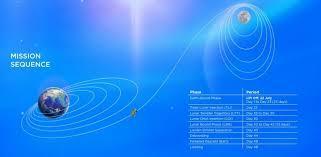
Earth and Lunar Orbits
The next set of maneuvers, getting the Orbiter into a polar orbit and lowering this from an elongated one to a near-circular one at about 100km x 100km also went exactly to plan. These complex maneuvers can be seen in Fig.1. The separation of the Vikram Lander (with the Rover inside) from the Orbiter also went perfectly as did the few more maneuvers to position the Lander correctly.
Descent of Vikram
In the early hours of September 7, the Lander started its descent to the Moon’s surface completely independently, without any directions or inputs from either Bengaluru Mission Control or the Orbiter. Using its various on-board sensors, cameras and guidance system, and its algorithms, the Lander conducted a series of maneuvers to select the best landing spot in the pre-identified location around 70 degrees South and 22 degrees East. Using the four throttle-able thrusters in its four corners, the Lander attempted to move from its lunar orbit to the selected spot avoiding craters, rocks or other obstacles, while drastically reducing its vertical velocity (i.e. speed) close to zero, eliminating any horizontal velocity or movement, to finally adopt an upright orientation and descend vertically to land as softly as possible. In the final few hundred metres, a central thruster was to clear lunar dust away from the landing spot to prevent clogging of systems or damage to instruments. The Lander could also have handled slopes of up to 12 degrees.
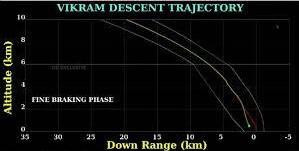
Vikram descent
From around 6 km per second at the start of descent, Lander speed had to be brought down rapidly to around 2 m/s and near-zero on landing. A “rough braking” in the initial phase from 30km to 7.5km was achieved by almost full-throttle firing of all four thrusters. At roughly 4km, Fig.2 shows the trajectory of the Lander almost exactly following the desired normal central curve, after which the “fine braking” final phase ensued, intended to bring the Lander down to about 400m, after which a purely vertical, slower descent was to complete the soft landing. But it was here that things started going wrong, Fig.2 shows the actual trajectory deviating from the planned normal. No signals were received after the Lander reached 2.1 km above the lunar surface.
The call-outs and occasional displays at Mission Control also revealed anomalies at this stage (Video recordings of these moments are available on the internet). Horizontal and vertical velocities, around 48 m/s and 36m/s respectively, seemed to this writer to be too high for the altitude at a point just before signals disappeared.
Over the next several weeks or perhaps months, much more information with many more data points are expected to become available from Mission Control, from the Orbiter, and from several other international monitoring stations, especially National Aeronautics and Space Administration’s (NASA’s) Deep Space Network. Only then will a full and accurate assessment of what actually happened in those last few seconds will become clear.
Science from the Mission
Several media reports have suggested that, despite the loss of the Lander and Rover, 90-95% of the Mission goals have already been accomplished because the Orbiter is still there with a scheduled life of 1 year. Such assessments are incorrect. Reality is that the soft landing was a very important goal of this Mission and will remain a monkey on ISRO’s back till it is successfully accomplished. This capability is essential particularly for future activities on the Moon’s surface. Since the Moon has virtually no atmosphere, parachute landings of rovers as are done on Mars are impossible, and powered landings are the only option. And of course, any humans landing on the Moon, establishing space stations there, etc., will not be possible without soft landings. Whether or not human missions are necessary or useful is a separate debate.
Also read: Sept 7 Softlanding on Moon Will be Biggest Chandrayaan-2 Mission Test For ISRO
Nevertheless, it is true that the data to be gathered by the Vikram Lander and Pragyan Rover would have been far less than that to be gathered by the Orbiter. The Lander and Rover both have a life of only 15 earth-days or 1 lunar day. They were to gather and relay back information on local topography, surface chemical composition, seismic activity etc. Clearly, the information gathered would have been limited. Witness are the tons of moon rocks collected and brought back by NASA astronauts that are, pardon the pun, gathering dust at NASA.
The Orbiter has a planned life of 1 year and information suggests it has enough fuel on board to extend this to 7 years! The Orbiter is to gather information regarding surface and sub-surface water molecules or water ice (the main purpose of going to the south polar region), mineralogical and chemical studies of the lunar surface, composition of the lunar exo-atmosphere and volatile compounds, and preparation of 3D maps of the lunar surface, study of solar x-rays, etc. All this will provide invaluable information to ISRO scientists and international colleagues from many space agencies and academic institutions the world over. So, indeed there is much to look forward to from Chandrayaan-2.
Counter-productive hype
Unfortunately, the government at the highest level, large sections of the media and the commentariat, had hyped the Mission and the “national pride” of over a billion Indians riding on it. So much so, that a pall of gloom and failure descended on the country, and unfortunately, on ISRO too. Two of the declared objectives of the Chandrayaan-2 Mission were to “foster a new age of discovery” and to “inspire a future generation of explorers and scientists.” Space exploration is indeed an exciting activity and calls for, as well as makes, great contributions to science and engineering. But it is also fraught with risks. Remember the astronauts killed on the launch pad in the first manned Apollo 1 mission in 1967, and the death of Kalpana Chawla and several others in Space Shuttle Columbia in 2003? The scientists and engineers in ISRO are fully aware of the risks, as much as they keep the knowledge dividends at the forefront. However, adding so much pressure on to ISRO scientists on top of the normal pressures of such a major mission is counter-productive and works against professional and efficient delivery of results. The wider public, too, needs to be aware of the risks as much as the rewards, and students, in particular, need to understand that science is not all about triumphs, records or coming first, but is also about hard knocks, repeated trials and experiments, and many failures along the way.
Also watch: Chandrayaan-2: Lander Fails But Not Everything's Lost
The country heard a lot of belated commiseration and consoling at Mission Control that fateful day when Vikram failed to land softly on the Moon. One wishes one had also heard declarations of resolve by ISRO to succeed the next time, and soon. And also heard commitment from the government to promptly make available the necessary funding for the next attempt.
Get the latest reports & analysis with people's perspective on Protests, movements & deep analytical videos, discussions of the current affairs in your Telegram app. Subscribe to NewsClick's Telegram channel & get Real-Time updates on stories, as they get published on our website.









